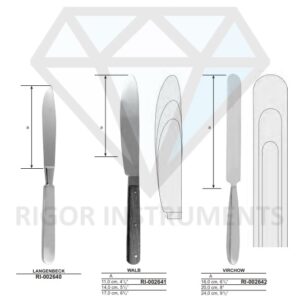Scalpel Handles (RI-002605)
Scalpel handles are essential surgical instruments used by medical professionals to hold and control the surgical blades during various procedures. These handles play a crucial role in achieving precision and accuracy during surgeries.Scalpel handles are indispensable tools in the field of surgery. Their sturdy construction, ergonomic design, and versatility make them essential instruments for medical professionals. With various types to choose from, surgeons can select the most appropriate scalpel handle for each surgical procedure, enabling precise control, safety, and optimal surgical outcomes.
Detailed Description
Technical Specifications
Packaging and Shipping
Related Products
Reviews
Detailed Description
Lorem ipsum dolor sit amet, consectetur adipiscing elit. Ut elit tellus, luctus nec ullamcorper mattis, pulvinar dapibus leo.
Technical Specifications
Lorem ipsum dolor sit amet, consectetur adipiscing elit. Ut elit tellus, luctus nec ullamcorper mattis, pulvinar dapibus leo.
Packaging and Shipping
Lorem ipsum dolor sit amet, consectetur adipiscing elit. Ut elit tellus, luctus nec ullamcorper mattis, pulvinar dapibus leo.
Related Products
Related products
-
Sale!

Surgical Scissors (RI-002650)
$8.00Original price was: $8.00.$7.00Current price is: $7.00. View More -

Scalpel Handle # 5 (RI-S-1003)
View More -

Scalpel Handle # 6 (RI-S-1012)
View More -
Sale!

Post Mortem Knives (RI-002640)
$12.00Original price was: $12.00.$11.00Current price is: $11.00. View More
Reviews
Reviews
Add a review
Be the first to review “Scalpel Handles (RI-002605)” Cancel reply
You must be logged in to post a review.












Reviews
There are no reviews yet.